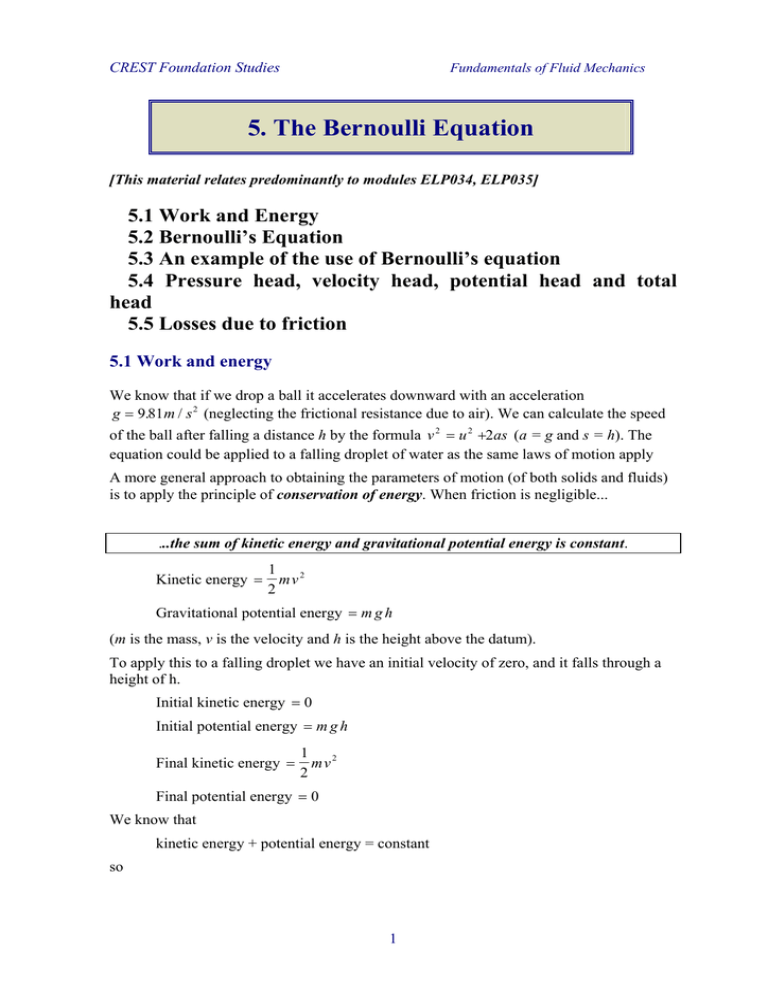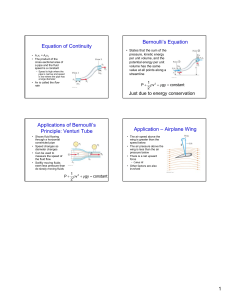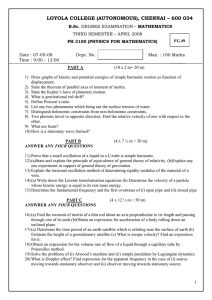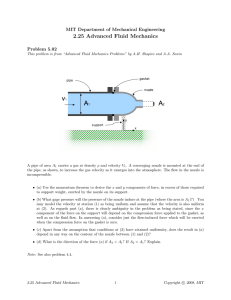UNIT 4 - Learn
advertisement

CREST Foundation Studies Fundamentals of Fluid Mechanics 5. The Bernoulli Equation [This material relates predominantly to modules ELP034, ELP035] 5.1 Work and Energy 5.2 Bernoulli’s Equation 5.3 An example of the use of Bernoulli’s equation 5.4 Pressure head, velocity head, potential head and total head 5.5 Losses due to friction 5.1 Work and energy We know that if we drop a ball it accelerates downward with an acceleration g = 9.81m / s 2 (neglecting the frictional resistance due to air). We can calculate the speed of the ball after falling a distance h by the formula v 2 = u 2 +2as (a = g and s = h). The equation could be applied to a falling droplet of water as the same laws of motion apply A more general approach to obtaining the parameters of motion (of both solids and fluids) is to apply the principle of conservation of energy. When friction is negligible... ...the sum of kinetic energy and gravitational potential energy is constant. Kinetic energy = 1 mv 2 2 Gravitational potential energy = m g h (m is the mass, v is the velocity and h is the height above the datum). To apply this to a falling droplet we have an initial velocity of zero, and it falls through a height of h. Initial kinetic energy = 0 Initial potential energy = m g h Final kinetic energy = 1 mv 2 2 Final potential energy = 0 We know that kinetic energy + potential energy = constant so 1 CREST Foundation Studies Fundamentals of Fluid Mechanics Initial kinetic energy + Initial potential energy = Final kinetic energy + Final potential energy mgh = 1 2 mv 2 so v = 2 gh Although this is applied to a drop of liquid, a similar method can be applied to a continuous jet of liquid. The Trajectory of a jet of water We can consider the situation as in the figure above - a continuous jet of water coming from a pipe with velocity u1 . One particle of the liquid with mass m travels with the jet and falls from height z1 to z 2 . The velocity also changes from u1 to u2 . The jet is travelling in air where the pressure is everywhere atmospheric so there is no force due to pressure acting on the fluid. The only force which is acting is that due to gravity. The sum of the kinetic and potential energies remains constant (as we neglect energy losses due to friction) so 1 1 mgz1 + mu12 = mgz2 + mu22 2 2 As m is constant this becomes 1 2 1 u1 + gz1 = u22 + gz 2 2 2 This will give a reasonably accurate result as long as the weight of the jet is large compared to the frictional forces. It is only applicable while the jet is whole - before it breaks up into droplets. Flow from a reservoir We can use a very similar application of the energy conservation concept to determine the velocity of flow along a pipe from a reservoir. Consider the ‘idealised reservoir’ in the figure below. 2 CREST Foundation Studies Fundamentals of Fluid Mechanics An idealised reservoir The level of the water in the reservoir is z1 . Considering the energy situation - there is no movement of water so kinetic energy is zero but the gravitational potential energy is mgz1 . If a pipe is attached at the bottom water flows along this pipe out of the tank to a level z 2 . A mass m has flowed from the top of the reservoir to the nozzle and it has gained a 1 velocity u2 . The kinetic energy is now mu22 and the potential energy mgz 2 . 2 Summarising Initial kinetic energy = 0 Initial potential energy = m g z1 Final kinetic energy = 1 mu22 2 Final potential energy = mgz 2 We know that kinetic energy + potential energy = constant so 1 2 mu + mgz2 2 2 1 mg ( z1 + z2 ) = mu22 2 mgz1 = so u2 = 2 g ( z1 − z2 ) We now have a expression for the velocity of the water as it flows from of a pipe nozzle at a height ( z1 − z 2 ) below the surface of the reservoir. (Neglecting friction losses in the pipe and the nozzle). Now apply this to this example: A reservoir of water has the surface at 310m above the outlet nozzle of a pipe with diameter 15mm. What is the a) velocity, b) the discharge out of the nozzle and c) mass flow rate. (Neglect all friction in the nozzle and the pipe). 3 CREST Foundation Studies Fundamentals of Fluid Mechanics u2 = 2 g ( z1 − z 2 ) = 2 × g × 310 = 78.0 m / s Volume flow rate is equal to the area of the nozzle multiplied by the velocity Q = Au = (π × 0.015 4 ) × 78.0 2 = 0.01378 m3 / s The density of water is 1000 kg / m3 so the mass flow rate is mass flow rate = density × volume flow rate = ρQ = 1000 × 0.01378 = 13.78 kg / s In the above examples the resultant pressure force was always zero as the pressure surrounding the fluid was the everywhere the same - atmospheric. If the pressures had been different there would have been an extra force acting and we would have to take into account the work done by this force when calculating the final velocity. We have already seen in the hydrostatics section an example of pressure difference where the velocities are zero. p1 z1 p2 z2 The pipe is filled with stationary fluid of density ρ has pressures p1 and p2 at levels z1 and z2 respectively. What is the pressure difference in terms of these levels? p2 − p1 = ρg ( z1 − z2 ) or p1 ρ + gz1 = p2 ρ + gz2 This applies when the pressure varies but the fluid is stationary. Compare this to the equation derived for a moving fluid but constant pressure: 4 CREST Foundation Studies Fundamentals of Fluid Mechanics 1 2 1 u1 + gz1 = u22 + gz 2 2 2 You can see that these are similar form. What would happen if both pressure and velocity varies? 5.2 Bernoulli’s Equation Bernoulli’s equation is one of the most important/useful equations in fluid mechanics. It may be written, p1 u12 p2 u22 + +z = + +z ρg 2 g 1 ρg 2 g 2 We see that from applying equal pressure or zero velocities we get the two equations from the section above. They are both just special cases of Bernoulli’s equation. Bernoulli’s equation has some restrictions in its applicability, they are: • Flow is steady; • Density is constant (which also means the fluid is incompressible); • Friction losses are negligible. • The equation relates the states at two points along a single streamline, (not conditions on two different streamlines). All these conditions are impossible to satisfy at any instant in time! Fortunately for many real situations where the conditions are approximately satisfied, the equation gives very good results. The derivation of Bernoulli’s Equation: Cross sectional area a B B’ A z A’ mg An element of fluid, as that in the figure above, has potential energy due to its height z above a datum and kinetic energy due to its velocity u. If the element has weight mg then potential energy = mgz potential energy per unit weight = z 5 CREST Foundation Studies kinetic energy = Fundamentals of Fluid Mechanics 1 2 mu 2 u2 kinetic energy per unit weight = 2g At any cross-section the pressure generates a force, the fluid will flow, moving the crosssection, so work will be done. If the pressure at cross section AB is p and the area of the cross-section is a then force on AB = pa when the mass mg of fluid has passed AB, cross-section AB will have moved to A’B’ volume passing AB = mg m = ρg ρ therefore distance AA’ = m ρa work done = force × distance AA’ = pa × m pm = ρa ρ work done per unit weight = p ρg This term is know as the pressure energy of the flowing stream. Summing all of these energy terms gives Pressure Kinetic Potential Total energy per + energy per + energy per = energy per unit weight unit weight unit weight unit weight or p u2 + +z = H ρg 2 g As all of these elements of the equation have units of length, they are often referred to as the following: pressure head = p ρg velocity head = u2 2g potential head = z total head = H 6 CREST Foundation Studies Fundamentals of Fluid Mechanics By the principle of conservation of energy the total energy in the system does not change, Thus the total head does not change. So the Bernoulli equation can be written p u2 + + z = H= Constant ρg 2 g As stated above, the Bernoulli equation applies to conditions along a streamline. We can apply it between two points, 1 and 2, on the streamline in the figure below Two points joined by a streamline total energy per unit weight at 1 = total energy per unit weight at 2 or total head at 1 = total head at 2 or p1 u12 p u2 + + z1 = 2 + 2 + z2 ρg 2 g ρg 2 g This equation assumes no energy losses (e.g. from friction) or energy gains (e.g. from a pump) along the streamline. It can be expanded to include these simply, by adding the appropriate energy terms: Total Total Loss Work done Energy energy per = energy per unit + per unit + per unit − supplied unit weight at 1 weight at 2 weight weight per unit weight p1 u12 p u2 + + z1 = 2 + 2 + z2 + h + w − q ρg 2 g ρg 2 g 5.3 An example of the use of the Bernoulli Equation When the Bernoulli equation is combined with the continuity equation the two can be used to find velocities and pressures at points in the flow connected by a streamline. Here is an example of using the Bernoulli equation to determine pressure and velocity at within a contracting and expanding pipe. 7 CREST Foundation Studies Fundamentals of Fluid Mechanics A contracting/expanding pipe A fluid of constant density ρ = 960 kg / m 3 is flowing steadily through the above tube. The diameters at the sections are d 1 = 100 mm and d 2 = 80mm . The gauge pressure at 1 is p1 = 200kN / m 2 and the velocity here is u1 = 5m / s . We want to know the gauge pressure at section 2. We shall of course use the Bernoulli equation to do this and we apply it along a streamline joining section 1 with section 2. The tube is horizontal, with z1 = z2 so Bernoulli gives us the following equation for pressure at section 2: p2 = p1 + ρ 2 (u12 − u22 ) But we do not know the value of u2 . We can calculate this from the continuity equation: Discharge into the tube is equal to the discharge out i.e. A1u1 = A2 u2 u2 = A1u1 A2 2 d1 u2 = u1 d2 = 7.8125 m / s So we can now calculate the pressure at section 2 p2 = 200000 − 17296.87 = 182703 N / m 2 = 182.7 kN / m 2 Notice how the velocity has increased while the pressure has decreased. The phenomenon that pressure decreases as velocity increases - sometimes comes in very useful in engineering. (It is on this principle that carburettor in many car engines work - pressure reduces in a contraction allowing a small amount of fuel to enter). 8 CREST Foundation Studies Fundamentals of Fluid Mechanics Here we have used both the Bernoulli equation and the Continuity principle together to solve the problem. Use of this combination is very common. We will be seeing this again frequently throughout the rest of the course. 5.4 Pressure Head, Velocity Head, Potential Head and Total Head By looking again at the example of the reservoir with which feeds a pipe we will see how these different heads relate to each other. Consider the reservoir below feeding a pipe which changes diameter and rises (in reality it may have to pass over a hill) before falling to its final level. Reservoir feeding a pipe To analyses the flow in the pipe we apply the Bernoulli equation along a streamline from point 1 on the surface of the reservoir to point 2 at the outlet nozzle of the pipe. And we know that the total energy per unit weight or the total head does not change - it is constant - along a streamline. But what is this value of this constant? We have the Bernoulli equation p1 u12 p2 u22 + +z = H = + +z ρg 2 g 1 ρg 2 g 2 We can calculate the total head, H, at the reservoir, p1 = 0 as this is atmospheric and atmospheric gauge pressure is zero, the surface is moving very slowly compared to that in the pipe so u1 = 0 , so all we are left with is total head = H = z1 the elevation of the reservoir. A useful method of analysing the flow is to show the pressures graphically on the same diagram as the pipe and reservoir. In the figure above the total head line is shown. If we attached piezometers at points along the pipe, what would be their levels when the pipe nozzle was closed? (Piezometers, as you will remember, are simply open ended vertical tubes filled with the same liquid whose pressure they are measuring). 9 CREST Foundation Studies Fundamentals of Fluid Mechanics Piezometer levels with zero velocity As you can see in the above figure, with zero velocity all of the levels in the piezometers are equal and the same as the total head line. At each point on the line, when u = 0 p +z = H ρg The level in the piezometer is the pressure head and its value is given by p . ρg What would happen to the levels in the piezometers (pressure heads) if the if water was flowing with velocity = u? We know from earlier examples that as velocity increases so pressure falls … Piezometer levels when fluid is flowing p u2 + +z = H ρg 2 g We see in this figure that the levels have reduced by an amount equal to the velocity head, u2 . 2g Now as the pipe is of constant diameter we know that the velocity is constant along the pipe so the velocity head is constant and represented graphically by the horizontal line shown. (this line is known as the hydraulic grade line). What would happen if the pipe were not of constant diameter? Look at the figure below where the pipe from the example above is replaced be a pipe of three sections with the middle section of larger diameter 10 CREST Foundation Studies Fundamentals of Fluid Mechanics Piezometer levels and velocity heads with fluid flowing in varying diameter pipes The velocity head at each point is now different. This is because the velocity is different at each point. By considering continuity we know that the velocity is different because the diameter of the pipe is different. Which pipe has the greatest diameter? Pipe 2, because the velocity, and hence the velocity head, is the smallest. This graphical representation has the advantage that we can see at a glance the pressures in the system. For example, where along the whole line is the lowest pressure head? It is where the hydraulic grade line is nearest to the pipe elevation i.e. at the highest point of the pipe. 5.5 Losses due to friction In a real pipe line there are energy losses due to friction - these must be taken into account as they can be very significant. How would the pressure and hydraulic grade lines change with friction? Going back to the constant diameter pipe, we would have a pressure situation like this shown below Hydraulic Grade line and Total head lines for a constant diameter pipe with friction How can the total head be changing? We have said that the total head - or total energy per unit weight - is constant. We are considering energy conservation, so if we allow for an amount of energy to be lost due to friction the total head will change. We have seen the equation for this before. But here it is again with the energy loss due to friction written as a head and given the symbol h f . This is often know as the head loss due to friction. 11 CREST Foundation Studies Fundamentals of Fluid Mechanics p1 u12 p2 u22 + +z = + +z +h ρg 2 g 1 ρg 2 g 2 f 12




